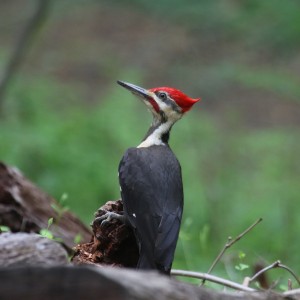By Mike Weilbacher
Join us on June 16th for coffee, donuts, and peak birding! The annual Nesting Bird Census is one of the many opportunities to engage in citizen science at the Schuylkill Center.
In early May, a small group of us spent a morning walking the Grey Fox loop, the long trail that ventures through diverse habitats meadows—Pine Grove, farms, a stream, and Wind Dance Pond—searching for birds that were then migrating through the Schuylkill Center’s extensive forest. There is a narrow window of opportunity to see them—and our group jumped through that window in style.
In a highly organized effort, birdwatchers fanned out across Pennsylvania to count migrating birds. For the first time in a few years, this effort included Philadelphia. While Roxborough was well represented in the count (other teams counted along River Road and the Upper Roxborough Reservoir Preserve), our group looked for which birds were using the Schuylkill Center as a migration stop.
Four hours and almost 300 birds and 52 species later, we submitted our census.
We counted plenty of year-round residents that you’d see if in December, or if you had bird feeders in your yard: the robin, cardinal, crow, and blue jay.
In addition, we saw two predatory birds. A red-tailed hawk rested in a large tree only a stone’s throw from Hagy’s Mill Road, oblivious to the traffic right below. Its rust-colored tail is a easy giveaway, but it also is the most common hawk in Pennsylvania. We also glimpsed a black vulture flying overhead. This soaring, thick-winged bird is a specialist in eating already-dead animals; call them nature’s garbage collectors.
What we were all secretly after were warblers, small jewel-like birds, most of whom migrate through Pennsylvania on their way to northern nesting grounds. Obsessive birdwatchers are out a lot this time of year, bending backwards staring high into trees, fighting off “warbler neck” to get a good view. For me, the Holy Grail is the Blackburnian warbler, its head a complicated and stunning helmet of orange-and-black striping. I have only seen a handful in a lifetime of birding, and none showed Saturday. Still, we did great in the warbler department.
Then there was the catch of the day: a large pileated woodpecker, the crow-sized songbird upon which Woody Woodpecker was modeled, a blackish bird with startling red crest, armed with a chisel-like beak that breaks off huge chunks of dead wood. Not seen easily or often, this one was focused like a laser beam on the ground around a dead tree trunk—possibly a colony of ants was warranting its attention. Two of the group were skilled photographers, and we made sure they got good shots.
There is a higher conservation purpose to all this. Between climate change and habitat loss, outdoor house cats prowling and too many shiny windows to fly into, bird populations are reeling. While Rachel Carson’s 1962 Silent Spring worried that pesticides like the now-banned DDT would remove birdsong from our experience of spring, other issues have arisen to take its place. As noted here last week, migrating birds like those warblers heading between nest sites in Canada and overwintering grounds in South America need protected habitats both in the north and in the south, not to mention in migration corridors along the way.
The Schuylkill Center was proud to participate in a conservation effort to document which migrating birds were passing through the region when. Over time, and with years of data, conservation scientists will be able to monitor trends.
While we were doing important science, we had the pleasure and honor to be in the presence of some pretty amazing creatures.
On June 16th, at the ungodly but very bird-appropriate hour of 6:30 a.m., fueled by coffee and donuts, we’ll fan out across the Schuylkill Center again, this time looking for nesting birds, as the migrants have moved on. We’ve been counting nesting birds for almost 50 years. Come help us continue this crucial citizen science effort and we’ll introduce you to some pretty cool creatures.
Mike Weilbacher directs the Schuylkill Center, tweets @SCEEMike, and can be reached at mike@schuylkillcenter.org.

